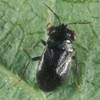Abstract
Big-eyed bugs are among those insects receiving research attention in Florida (and elsewhere) for their value as predators. To aid in identification of big-eyed bugs in Florida, a key to adults and late instar nymphs is provided in this publication. This 6-page fact sheet was written by F. W. Mead and published by the UF Department of Entomology and Nematology, March 2011.
EENY252/IN517: Bigeyed Bugs, Geocoris spp. (Insecta: Hemiptera: Geocoridae) (ufl.edu)
References
Anonymous. (May 2000). Color photographs of adult Geocoris bullatus (Say) and Geocoris uliginosus (Say). Cedar Creek Natural History Area. http://www.cedarcreek.umn.edu/insects/album/020007018ap.html (29 November 2001).
Bell KO, Whitcomb WH. 1964. Field studies on egg predators of the bollworm, Heliothis zea (Boddie). Florida Entomologist 47: 171-180. https://doi.org/10.2307/3493322
Blatchley WS. 1926. Heteroptera or true bugs of Eastern North America, with especial reference to the faunas of Indiana and Florida. Nature Publishing Co., Indianapolis. 1116 p. https://doi.org/10.5962/bhl.title.6871
Caplan I. 1968. Some chinch bugs aren't. Weeds Trees and Turf 7: 31-32.
Champlain RA, Sholdt LL. 1967. Life history of Geocoris punctipes (Hemiptera: Lygaeidae) in the laboratory. Annals of the Entomological Society of America 60: 883-885. https://doi.org/10.1093/aesa/60.5.883
DeCoursey RM. 1971. Keys to the families and subfamilies of the nymphs of North American Hemiptera-Heteroptera. Proceedings of the Entomological Society of Washington 73: 413-428.
Dumas BA, Boyer WP, Whitcomb WH. 1962. Effect of time of day on surveys of predaceous insects in field crops. Florida Entomologist 45: 121-128. https://doi.org/10.2307/3492562
Herring JL, Ashlock PD. 1971. A key to the nymphs of the families of Hemiptera (Heteroptera) of America north of Mexico. Florida Entomologist 54: 207-212. https://doi.org/10.2307/3493715
Lingren PD, Ridgay RL, Jones SL. 1968. Consumption by several common arthropod predators of eggs and larvae of two Heliothis species that attack cotton. Annals of the Entomological Society of America 61: 613-618. https://doi.org/10.1093/aesa/61.3.613
McGregor EA, McDonough FL. 1917. The red spider on cotton. USDA Bulletin 416: 41- 43. https://doi.org/10.5962/bhl.title.109006
Orhanides GM, Gonzalez D, Bartlett BR. 1971. Identification and evaluation of pink bollworm predators in southern California. Journal of Economic Entomology 64: 421-424. https://doi.org/10.1093/jee/64.2.421
Stoner A. 1970. Plant feeding by a predaceous insect, Geocoris punctipes. Journal of Economic Entomology 63: 1911-1915. https://doi.org/10.1093/jee/63.6.1911
Sweet MH. 1960. The seed bugs: A contribution to the feeding habits of the Lygaeidae (Hemiptera: Heteroptera). Annals of the Entomological Society of America 53: 317-321. https://doi.org/10.1093/aesa/53.3.317
Sweet MH, Slater JA. 1961. A generic key to the nymphs of North American Lygaeidae (Hemiptera: Heteroptera). Annals of the Entomological Society of America 54: 333-340. https://doi.org/10.1093/aesa/54.3.333
Tamaki G, Weeks RE. 1972. Biology and ecology of two predators, Geocoris pallens Stäl and G. bullatus (Say). U.S. Department of Agriculture Technical Bulletin 1446. 46 p.
Whitcomb WH, Bell K. 1964. Predaceous insects, spiders, and mites of Arkansas cotton fields. Arkansas Agricultural Experiment Station Bulletin 690. 84 p.
York GT. 1944. Food studies of Geocoris spp., predators of the beet leafhopper. Journal of Economic Entomology 37: 25-29. https://doi.org/10.1093/jee/37.1.25

